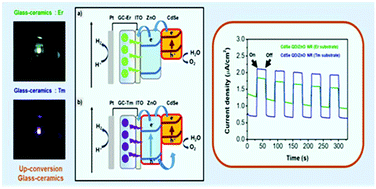Our official English website, www.x-mol.net, welcomes your
feedback! (Note: you will need to create a separate account there.)
Enhanced IR-driven photoelectrochemical responses of CdSe/ZnO heterostructures by up-conversion UV/visible light irradiation
Nanoscale ( IF 5.8 ) Pub Date : 2020/03/09 , DOI: 10.1039/d0nr00477d Joo-Won Lee 1, 2, 3, 4 , Ki-Hyun Cho 5, 6, 7, 8 , Joon-Soo Yoon 1, 2, 3, 4 , Yun-Mo Sung 1, 2, 3, 4
Nanoscale ( IF 5.8 ) Pub Date : 2020/03/09 , DOI: 10.1039/d0nr00477d Joo-Won Lee 1, 2, 3, 4 , Ki-Hyun Cho 5, 6, 7, 8 , Joon-Soo Yoon 1, 2, 3, 4 , Yun-Mo Sung 1, 2, 3, 4
Affiliation

|
We, for the first time, report the development of infrared (IR)-driven photoelectrochemical (PEC) cells using up-conversion glass-ceramics as substrates, which is different from the previous strategies of decorating photocatalysts with up-conversion (UC) rare earth-doped fluoride nanoparticles to utilize IR light. Our approach is more efficient since the use of UC glass-ceramics as substrates of photocatalysts could overcome the chemical instability of fluoride nanoparticles, the blockage of incident light, and the limited exposure of photocatalysts to liquid electrolytes. Oxyfluoride glass-ceramics bearing (Yb,Er)-doped YF3 and (Yb,Tm)-doped YF3 nanocrystals turned out to generate UC green and ultraviolet/blue emissions, respectively, under 980 nm illumination. High-density ZnO nanorods were grown on the up-conversion glass-ceramic substrates by the hydrothermal method and they were subsequently overcoated with CdSe nanocrystals to obtain CdSe/ZnO heterostructures by the chemical bath deposition method. CdSe nanoparticles were excited by both the UC UV emission from Tm and the visible emission from Er and Tm, while ZnO nanorods were excited mostly by the UC UV emission from Tm. Because of the difference in the UC emissions from Er and Tm, two distinct carrier transportations, sensitization and type-II cascade, occurred in the identical CdSe/ZnO heterostructures. Eventually, CdSe/ZnO fabricated on the glass-ceramics bearing (Yb,Tm)-doped YF3 showed increased photocurrent density compared to that fabricated on the glass-ceramics bearing (Yb,Er)-doped YF3 due to the charge separation activated by the type-II cascade structure.
中文翻译:

上转换UV /可见光辐射增强CdSe / ZnO异质结构的红外驱动光电化学反应
我们首次报告了以上转换玻璃陶瓷为基底的红外(IR)驱动的光电化学(PEC)细胞的开发,这与以前用上转换(UC)稀有装饰光催化剂的策略不同掺土氟化物纳米颗粒可利用红外光。我们的方法更有效,因为使用UC玻璃陶瓷作为光催化剂的底物可以克服氟化物纳米粒子的化学不稳定性,入射光的阻挡以及光催化剂在液体电解质中的有限暴露。掺有(Yb,Er)的YF 3和掺有(Yb,Tm)的YF 3的氟氧化物玻璃陶瓷纳米晶体在980 nm的光照下分别产生UC绿光和紫外/蓝光。通过水热法在高转化率的玻璃陶瓷基板上生长高密度ZnO纳米棒,然后通过化学浴沉积法在其上覆盖CdSe纳米晶体,以获得CdSe / ZnO异质结构。Td的UC UV发射和Er和Tm的可见光都激发了CdSe纳米颗粒,而ZnO纳米棒主要被Tm的UC UV发射了激发。由于Er和Tm的UC排放量不同,在相同的CdSe / ZnO异质结构中发生了两种不同的载流子传输:敏化和II型级联。最终,在掺有(Yb,Tm)的YF 3掺杂玻璃陶瓷上制造了CdSe / ZnO。由于由II型级联结构激活的电荷分离,与在掺有(Yb,Er)的玻璃陶瓷中掺入的YF 3相比,显示出增加的光电流密度。
更新日期:2020-04-17
中文翻译:

上转换UV /可见光辐射增强CdSe / ZnO异质结构的红外驱动光电化学反应
我们首次报告了以上转换玻璃陶瓷为基底的红外(IR)驱动的光电化学(PEC)细胞的开发,这与以前用上转换(UC)稀有装饰光催化剂的策略不同掺土氟化物纳米颗粒可利用红外光。我们的方法更有效,因为使用UC玻璃陶瓷作为光催化剂的底物可以克服氟化物纳米粒子的化学不稳定性,入射光的阻挡以及光催化剂在液体电解质中的有限暴露。掺有(Yb,Er)的YF 3和掺有(Yb,Tm)的YF 3的氟氧化物玻璃陶瓷纳米晶体在980 nm的光照下分别产生UC绿光和紫外/蓝光。通过水热法在高转化率的玻璃陶瓷基板上生长高密度ZnO纳米棒,然后通过化学浴沉积法在其上覆盖CdSe纳米晶体,以获得CdSe / ZnO异质结构。Td的UC UV发射和Er和Tm的可见光都激发了CdSe纳米颗粒,而ZnO纳米棒主要被Tm的UC UV发射了激发。由于Er和Tm的UC排放量不同,在相同的CdSe / ZnO异质结构中发生了两种不同的载流子传输:敏化和II型级联。最终,在掺有(Yb,Tm)的YF 3掺杂玻璃陶瓷上制造了CdSe / ZnO。由于由II型级联结构激活的电荷分离,与在掺有(Yb,Er)的玻璃陶瓷中掺入的YF 3相比,显示出增加的光电流密度。











































 京公网安备 11010802027423号
京公网安备 11010802027423号